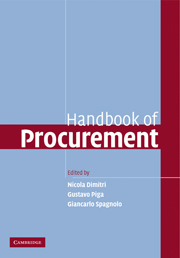Book contents
- Frontmatter
- Contents
- List of figures
- List of tables
- List of contributors
- Preface
- Part I Preliminary Issues
- Part II General Strategic Principles
- Part III Competitive Tendering Strategies
- 6 Information and competitive tendering
- 7 Division into lots and competition in procurement
- 8 Multi-contract tendering procedures and package bidding in procurement
- 9 Dynamic auctions in procurement
- Part IV Attracting and Screening Participants
- Part V Preventing Collusion and Corruption
- Part VI Dynamic Forces and Innovation
- Glossary
- Index
- References
8 - Multi-contract tendering procedures and package bidding in procurement
Published online by Cambridge University Press: 04 November 2009
- Frontmatter
- Contents
- List of figures
- List of tables
- List of contributors
- Preface
- Part I Preliminary Issues
- Part II General Strategic Principles
- Part III Competitive Tendering Strategies
- 6 Information and competitive tendering
- 7 Division into lots and competition in procurement
- 8 Multi-contract tendering procedures and package bidding in procurement
- 9 Dynamic auctions in procurement
- Part IV Attracting and Screening Participants
- Part V Preventing Collusion and Corruption
- Part VI Dynamic Forces and Innovation
- Glossary
- Index
- References
Summary
Introduction
In practical procurement, the most common way to purchase multiple supply contracts – of different types, say, or for different geographical areas – is probably the simultaneous sealed-bid competitive tendering of several distinct contracts. In this competitive bidding procedure, when tenders are only economic, suppliers make a separate bid for each contract and each contract is awarded to the supplier who makes the lowest bid, at a price equal to his bid. Typically, the chance that a supplier is awarded a particular contract is independent of the bids he submits on any other contract.
This simple way of awarding supply contracts may be appropriate when the cost of supplying each contract is independent of which other contracts a supplier is serving. But, in reality, a supplier's cost of serving a contract often depends on how many, and which, other contracts he also supplies. When this is the case, the procurer should allow suppliers to submit offers that can take such relations into account. For example, when the average cost of serving two adjacent regions is substantially lower than that of serving just one of the two areas – say because part of the fixed investment required can be used for both areas – bidders should be allowed to tender offers whose conditions are valid only if they are awarded the service contracts for both adjacent regions.
- Type
- Chapter
- Information
- Handbook of Procurement , pp. 193 - 219Publisher: Cambridge University PressPrint publication year: 2006
References
- 5
- Cited by



